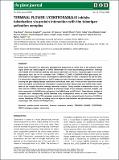Files in this item
TERMINAL FLOWER-1/CENTRORADIALIS inhibits tuberization via protein interaction with the tuberigen activation complex
Item metadata
| dc.contributor.author | Zhang, Xing | |
| dc.contributor.author | Campbell, Raymond | |
| dc.contributor.author | Ducreux, Laurence J. M. | |
| dc.contributor.author | Morris, Jennifer | |
| dc.contributor.author | Hedley, Pete E | |
| dc.contributor.author | Mellado-Ortega, Elena | |
| dc.contributor.author | Roberts, Alison G | |
| dc.contributor.author | Stephens, Jennifer | |
| dc.contributor.author | Bryan, Glenn J | |
| dc.contributor.author | Torrance, Lesley | |
| dc.contributor.author | Chapman, Sean N | |
| dc.contributor.author | Prat, Salomé | |
| dc.contributor.author | Taylor, Mark A | |
| dc.date.accessioned | 2020-07-20T15:30:06Z | |
| dc.date.available | 2020-07-20T15:30:06Z | |
| dc.date.issued | 2020-07-14 | |
| dc.identifier | 268762602 | |
| dc.identifier | a28e9485-1ecd-416a-be4f-962a7581597f | |
| dc.identifier | 32593210 | |
| dc.identifier | 000548226800001 | |
| dc.identifier | 85087896753 | |
| dc.identifier.citation | Zhang , X , Campbell , R , Ducreux , L J M , Morris , J , Hedley , P E , Mellado-Ortega , E , Roberts , A G , Stephens , J , Bryan , G J , Torrance , L , Chapman , S N , Prat , S & Taylor , M A 2020 , ' TERMINAL FLOWER-1/CENTRORADIALIS inhibits tuberization via protein interaction with the tuberigen activation complex ' , The Plant Journal , vol. Early View . https://doi.org/10.1111/tpj.14898 | en |
| dc.identifier.issn | 0960-7412 | |
| dc.identifier.uri | https://hdl.handle.net/10023/20292 | |
| dc.description | This work was funded by the Scottish Government Rural and Environment Science and Analytical Services Division as part of the Strategic Research Programme 2016-2021, by a GCRF Foundation Awards for Global Agricultural and Food Systems Research funded by the BBSRC project BB/P022553/1 and also received funding from the European Union’s Horizon 2020 research and innovation programme under the Marie Skłodowska-Curie grant agreement number 835704. Research in Prat’s lab was funded by the Spanish Ministerio de Economía y Competitividad BIO2015-73019-EXP, and the aligned Japan EIG CONCERT (PIA102017-1) projects. | en |
| dc.description.abstract | Potato tuber formation is a secondary developmental program by which cells in the subapical stolon region divide and radially expand, to further differentiate into starch accumulating parenchyma. Whilst some details of the molecular pathway that signals tuberization are known, important gaps in our knowledge persist. Here the role of a member of the TERMINAL FLOWER 1/ CENTRORADIALIS gene family (termed StCEN ) in the negative control of tuberization is demonstrated for the first time. It is shown that reduced expression of StCEN accelerates tuber formation whereas transgenic lines over‐expressing this gene display delayed tuberization and reduced tuber yield. Protein‐protein interaction studies (yeast two hybrid and bimolecular fluorescence complementation) demonstrate that StCEN binds components of the recently described tuberigen activation complex. Using transient transactivation assays we show that the StSP6A tuberization signal is an activation target of the tuberigen activation complex, and that co‐expression of StCEN blocks StFD‐Like‐1 activation of the StSP6A gene. Transcriptomic analysis of transgenic lines mis‐expressing StCEN identify early transcriptional events in tuber formation. These results demonstrate that StCEN suppresses tuberization by directly antagonizing StSP6A function in stolons, identifying StCEN as a breeding marker to improve tuber initiation and yield, through the selection of genotypes with reduced StCEN expression. | |
| dc.format.extent | 16 | |
| dc.format.extent | 792025 | |
| dc.language.iso | eng | |
| dc.relation.ispartof | The Plant Journal | en |
| dc.subject | Protein-protein interaction | en |
| dc.subject | Solanum tuberosum (potato) | en |
| dc.subject | TERMINAL FLOWER 1/CENTRORADIALIS | en |
| dc.subject | Tuberigen complex | en |
| dc.subject | Tuberisation | en |
| dc.subject | QH301 Biology | en |
| dc.subject | DAS | en |
| dc.subject.lcc | QH301 | en |
| dc.title | TERMINAL FLOWER-1/CENTRORADIALIS inhibits tuberization via protein interaction with the tuberigen activation complex | en |
| dc.type | Journal article | en |
| dc.contributor.sponsor | BBSRC | en |
| dc.contributor.institution | University of St Andrews. School of Biology | en |
| dc.contributor.institution | University of St Andrews. Biomedical Sciences Research Complex | en |
| dc.identifier.doi | https://doi.org/10.1111/tpj.14898 | |
| dc.description.status | Peer reviewed | en |
| dc.identifier.grantnumber | BB/P022553/1 | en |
This item appears in the following Collection(s)
Items in the St Andrews Research Repository are protected by copyright, with all rights reserved, unless otherwise indicated.

